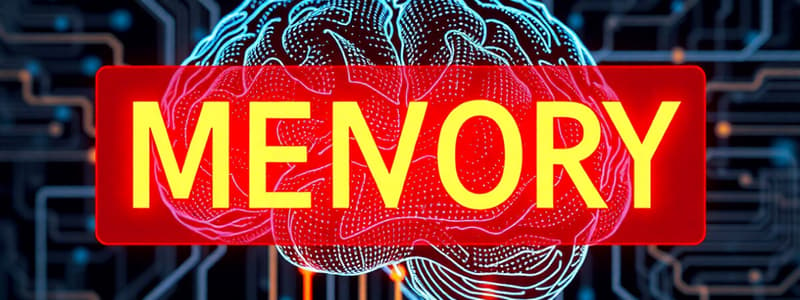Podcast
Questions and Answers
What is the definition of memory?
What is the definition of memory?
The ability to store and retrieve information over time.
What is the process of encoding?
What is the process of encoding?
Transforming perceived, thought, or felt information into a lasting memory.
What is the process of storage?
What is the process of storage?
Maintaining information in memory over time.
What is the process of retrieval?
What is the process of retrieval?
How is memory a construction?
How is memory a construction?
What are the three main ways information is encoded into the brain?
What are the three main ways information is encoded into the brain?
What are the three types of semantic judgments?
What are the three types of semantic judgments?
What is semantic encoding?
What is semantic encoding?
What is visual imagery encoding?
What is visual imagery encoding?
What is organizational encoding?
What is organizational encoding?
What is the difference between sensory memory and short-term memory?
What is the difference between sensory memory and short-term memory?
What are the two types of sensory memory?
What are the two types of sensory memory?
What is rehearsal?
What is rehearsal?
What is the serial position effect?
What is the serial position effect?
What is the primacy effect?
What is the primacy effect?
What is the approximate size of short-term memory?
What is the approximate size of short-term memory?
How can short-term memory be increased?
How can short-term memory be increased?
What are the elements of working memory?
What are the elements of working memory?
What is the visuospatial sketchpad?
What is the visuospatial sketchpad?
What is the phonological loop?
What is the phonological loop?
What is the episodic buffer?
What is the episodic buffer?
What is the central executive?
What is the central executive?
What is long-term memory?
What is long-term memory?
What was Dr. Brenda Milner's significant contribution to the understanding of long-term memory?
What was Dr. Brenda Milner's significant contribution to the understanding of long-term memory?
What is anterograde amnesia?
What is anterograde amnesia?
What is consolidation?
What is consolidation?
What is the role of the neural synapse in long-term memory storage?
What is the role of the neural synapse in long-term memory storage?
What changes occur in the synapse when new memories are created?
What changes occur in the synapse when new memories are created?
What is a retrieval cue?
What is a retrieval cue?
Explain the encoding specificity principle.
Explain the encoding specificity principle.
What is state-dependent retrieval?
What is state-dependent retrieval?
What is transfer-appropriate processing?
What is transfer-appropriate processing?
How can memories be changed by the act of retrieval?
How can memories be changed by the act of retrieval?
What is eyewitness testimony?
What is eyewitness testimony?
What is the difference between trying to recall and successfully recalling information?
What is the difference between trying to recall and successfully recalling information?
What are the two main types of long-term memory?
What are the two main types of long-term memory?
What is procedural memory?
What is procedural memory?
What is priming?
What is priming?
What are the two types of priming?
What are the two types of priming?
What is the difference between semantic and episodic memory?
What is the difference between semantic and episodic memory?
How is episodic memory connected to imagination and creativity?
How is episodic memory connected to imagination and creativity?
What is divergent and creative thinking?
What is divergent and creative thinking?
What is the alternate uses task (AUT)?
What is the alternate uses task (AUT)?
What is a nominal group?
What is a nominal group?
What are the pros and cons of collaborative memory?
What are the pros and cons of collaborative memory?
What is transitive memory?
What is transitive memory?
What are the seven memory 'sins' and possible benefits of each?
What are the seven memory 'sins' and possible benefits of each?
What is transience?
What is transience?
What are the types of interference that can lead to forgetting?
What are the types of interference that can lead to forgetting?
What is retroactive interference?
What is retroactive interference?
What is childhood, or infantile amnesia?
What is childhood, or infantile amnesia?
What is absentmindedness?
What is absentmindedness?
What is prospective memory?
What is prospective memory?
What is intentional offloading?
What is intentional offloading?
What is memory misattribution?
What is memory misattribution?
What is source memory?
What is source memory?
What is déjà vu?
What is déjà vu?
What is false recognition?
What is false recognition?
What is suggestibility?
What is suggestibility?
What is bias?
What is bias?
What are the types of bias in memory?
What are the types of bias in memory?
What is consistency bias?
What is consistency bias?
What is change bias?
What is change bias?
What is egocentric bias?
What is egocentric bias?
What are flashbulb memories?
What are flashbulb memories?
How does the amygdala play a role in persistence?
How does the amygdala play a role in persistence?
Flashcards
Define Memory
Define Memory
The ability to store and retrieve information over time.
Define Encoding
Define Encoding
Transforming what we perceive, think, or feel into an enduring memory.
Define Storage
Define Storage
Maintaining information in memory over time.
Define Retrieval
Define Retrieval
Signup and view all the flashcards
How is Memory a Construction?
How is Memory a Construction?
Signup and view all the flashcards
The 3 Main Ways Information is Encoded
The 3 Main Ways Information is Encoded
Signup and view all the flashcards
The 3 Types of Semantic Judgements
The 3 Types of Semantic Judgements
Signup and view all the flashcards
Semantic Encoding
Semantic Encoding
Signup and view all the flashcards
Visual Imagery Encoding
Visual Imagery Encoding
Signup and view all the flashcards
Visual Imagery Encoding for Verbal Information
Visual Imagery Encoding for Verbal Information
Signup and view all the flashcards
Why We Remember Survival-Related Information Well
Why We Remember Survival-Related Information Well
Signup and view all the flashcards
Sensory Memory vs. Short-Term Memory
Sensory Memory vs. Short-Term Memory
Signup and view all the flashcards
Two Types of Sensory Memory
Two Types of Sensory Memory
Signup and view all the flashcards
Define Rehearsal
Define Rehearsal
Signup and view all the flashcards
Define the Serial Position Effect
Define the Serial Position Effect
Signup and view all the flashcards
Define the Primacy Effect
Define the Primacy Effect
Signup and view all the flashcards
Define the Recency Effect
Define the Recency Effect
Signup and view all the flashcards
Size of Short-Term Memory
Size of Short-Term Memory
Signup and view all the flashcards
How to Increase Short-Term Memory
How to Increase Short-Term Memory
Signup and view all the flashcards
Elements of Working Memory
Elements of Working Memory
Signup and view all the flashcards
Visuospatial Sketchpad
Visuospatial Sketchpad
Signup and view all the flashcards
Phonological Loop
Phonological Loop
Signup and view all the flashcards
Episodic Buffer
Episodic Buffer
Signup and view all the flashcards
Central Executive
Central Executive
Signup and view all the flashcards
Define Long-Term Memory
Define Long-Term Memory
Signup and view all the flashcards
Dr. Brenda Milner
Dr. Brenda Milner
Signup and view all the flashcards
Anterograde Amnesia
Anterograde Amnesia
Signup and view all the flashcards
Retrograde Amnesia
Retrograde Amnesia
Signup and view all the flashcards
Define Consolidation
Define Consolidation
Signup and view all the flashcards
Define Reconsolidation
Define Reconsolidation
Signup and view all the flashcards
Consolidation
Consolidation
Signup and view all the flashcards
The Role of Neural Synapse in Memory Storage
The Role of Neural Synapse in Memory Storage
Signup and view all the flashcards
Creating a New Memory Might Involve
Creating a New Memory Might Involve
Signup and view all the flashcards
Study Notes
Memory Processes
- Memory is the ability to store and retrieve information over time.
- Encoding, storage, and retrieval are the three basic aspects of memory.
- Encoding involves transforming perceived, thought, or felt information into a lasting memory.
- Storage is the process of keeping information in memory over time.
- Retrieval involves calling to mind previously encoded and stored information.
- Memories are constructed by combining existing knowledge with new sensory information, therefore memories are constructions, combining what we know with new input
- Encoding methods include:
- Semantic encoding: relating new information to existing knowledge (e.g., remembering events, not digits). Active areas are the lower left frontal lobe and the inner left temporal lobe, greater activity here correlates with better recall.
- Visual imagery encoding: creating mental images to store information. Relating new info to already existing memories helps this process.
- Organizational encoding: categorizing information based on relationships.
Semantic Judgments
- Three types of semantic judgments involve thinking about the meaning, sound, or appearance of words.
Sensory Memory vs. Short-Term Memory
- Sensory memory holds information briefly (seconds or less).
- Two types of sensory memory:
- Iconic memory (visual)
- Echoic memory (auditory)
- Short-term memory holds information for longer durations (seconds to minutes).
Short-Term Memory
- Capacity: approximately 7 meaningful items.
- Rehearsal: repeating information to maintain it in short-term memory.
- Serial position effect: better recall of first and last items in a list (primary and recency effects).
- Primary effect: better recall of initial items due to greater rehearsal opportunities.
- Recency effect: better recall of final items due to recent presence in short-term memory.
- Chunking: combining small bits of information into larger, manageable chunks to increase short-term memory capacity.
Working Memory
- Working memory actively maintains information in short-term storage; uses multiple subsystems:
- Visuospatial sketchpad: for visual images.
- Phonological loop: for verbal information.
- Episodic buffer: combines visual and verbal information into a single code, acts as a gateway to long-term memory.
- Central executive: coordinates subsystems and the episodic buffer.
Long-Term Memory
- Holds information for extended periods (hours, days, weeks, years).
- Brenda Milner’s work was crucial in identifying the critical role of the hippocampus in long-term memory formation.
- Long-term memory involves processing and transferring information from short-term memory into long-term storage.
- Anterograde amnesia: inability to transfer new information from short-term into long-term memory.
- Retrograde amnesia: inability to retrieve information acquired before a certain date/point.
- Consolidation: the process of making memories stable in the brain.
- Reconsolidation: a process where retrieved memories are potentially altered before being stored again.
- Neural Synapses in Memory:
- Neurons that fire together wire together (more firing strengthens connection).
- Long-term potentiation (LTP): strengthens synaptic connections, resulting in easier communication between neurons. LTP is involved in memory formation.
- Changes in neural synapses support both short and long-term memory storage; increased neurotransmitter release = short-term; new synapse growth = long-term.
Retrieval
- Retrieval is bringing previously stored information to mind.
- Retrieval cues: external information that helps access stored memories.
- Encoding specificity principle: retrieval is enhanced when the context of retrieval matches the context of encoding (e.g., studying in the same room as the test).
- State-dependent retrieval: retrieving information more effectively when in the same physiological or emotional state as during encoding.
- Transfer-appropriate processing: matching the contexts of encoding and retrieval situations enhances retrieval.
- Retrieval-induced forgetting: retrieving an item impairs the recall of related items.
Types of Long-Term Memory
- Explicit memory: conscious retrieval of past experiences.
- Implicit memory: past experiences influence later behavior without conscious effort or awareness.
- Procedural memory: gradually acquired skills; automatic execution of tasks (e.g., playing an instrument).
- Priming: enhanced ability to process a stimulus due to prior exposure.
- Perceptual priming: recalling sensory features of an item.
- Conceptual priming: recalling the meaning of a word or object.
- Semantic memory: network of associated facts and concepts (general knowledge).
- Episodic memory: collection of personal experiences at specific times and places (autobiographical).
Collaborative Memory
- Collaborative memory: groups can sometimes recall more than individuals, but certain limitations and social dynamics can also negatively affect recall.
- Transitive memory: specific individuals in close relationships remember certain pieces of information.
Seven Sins of Memory
- Transience: forgetting over time.
- Absentmindedness: lapses in attention.
- Blocking: temporary inability to retrieve information.
- Misattribution: assigning memories to incorrect sources.
- Suggestibility: incorporating misleading information.
- Bias: present knowledge influencing recall.
- Persistence: intrusive memories that can't be forgotten.
Factors Affecting Memory
- Interference: retroactive (later learning impairs earlier) and proactive (earlier learning impairs later).
- Childhood amnesia: few memories from early childhood.
Studying That Suits You
Use AI to generate personalized quizzes and flashcards to suit your learning preferences.




